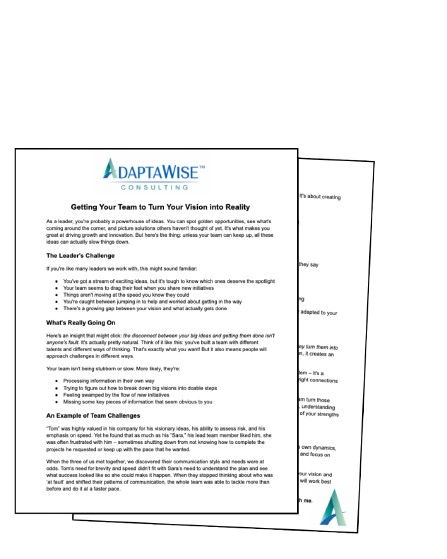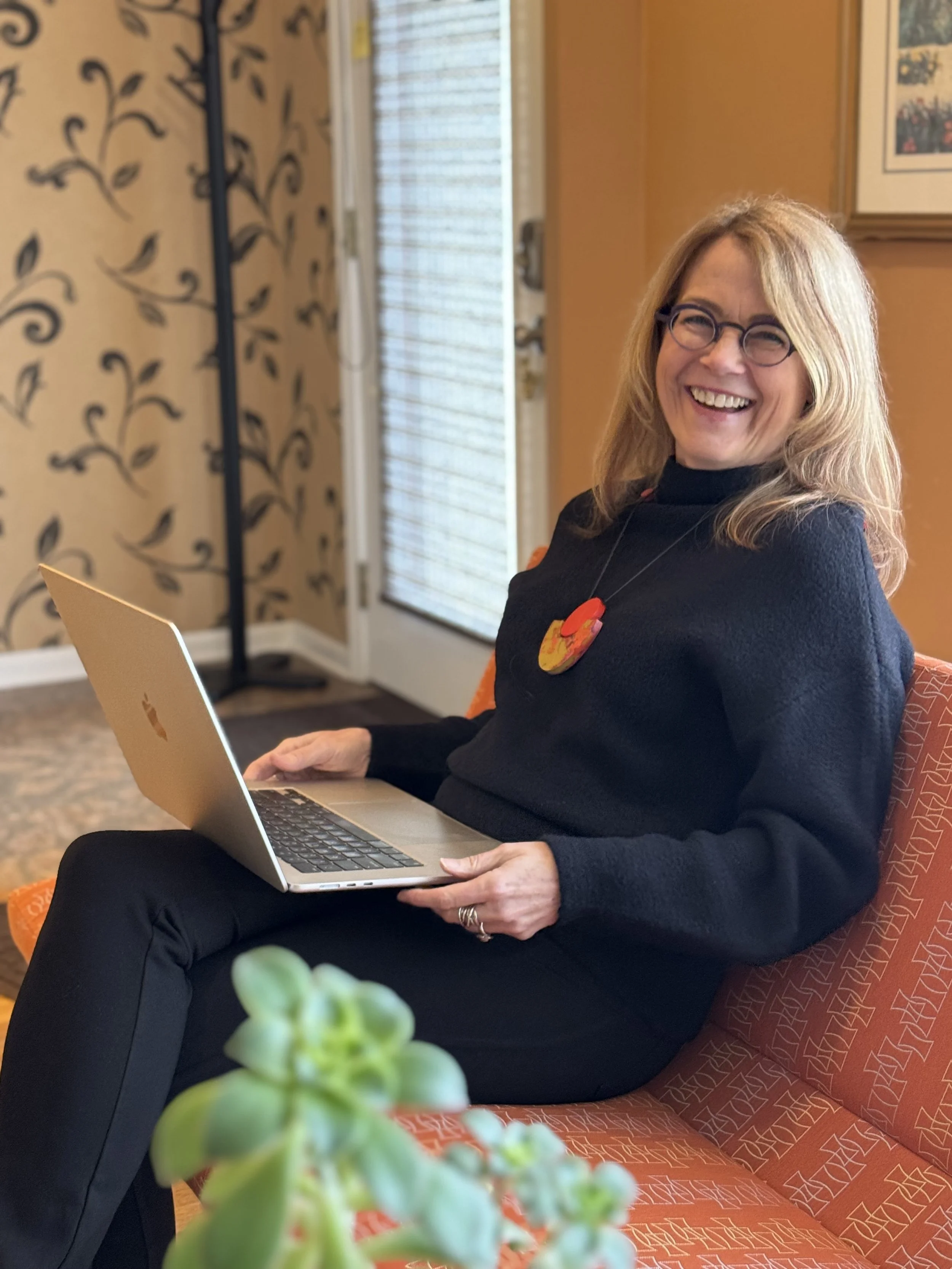Turn Your Visionary Ideas into Results-Driven Action
Leader Excellence:
The Pathway to Becoming Your Best
In this video + summary:
How to prioritize your great ideas for solid execution on what matters most.
How to shift from being the ‘hub’ to building a self-sustaining system.
How to avoid frustration and leverage the strengths of your team.
Team Excellence:
Optimizing Leadership Team Performance
In this video + summary:
Why typical team-building activities fail to solve real business problems
The hidden reasons your leadership team struggles with missed deadlines and new ideas.
A practical approach that links team improvement to measurable business results.

“Working with Nancy helped me identify and confidently make the changes I wanted in the way I lead and communicate.”
— Jamie McNaughton, VP, McNaughton Inc.
“If you are a leader facing real pressure or part of a leadership team struggling to move as one, I cannot recommend Dr. Nancy Jonker highly enough.”
— James Waite, CEO, Roberson Waite Electric
“Because of Nancy, I built my team on a strong culture from day one, which made scaling smooth.”
— Frances Walker, Owner, Frances Walker Businesses LLC
Who & How I Help
Visionaries / CEO’s
Support for founders and CEOs navigating the hidden challenges of leadership — turning complexity into clarity so they can lead with focus, stay out of overwhelm, and operate at their best.
Leadership Teams
Systemic coaching for leadership teams to improve communication, alignment, and execution — so the team works better together and consistently drives results across the business.
Partnerships + Family Businesses
Guided support for business partners to strengthen trust, clarify roles, navigate tough conversations, and plan for what’s next — so the partnership (and succession) works as well as the business itself.

“Before working with Nancy, I avoided hard conversations. She helped me face them directly—and with kindness—before they became bigger problems.”
— Ryan Knibbe, Englsema Homes
"Within just the first two sessions of working with Dr. Nancy, I learned things that justified my investment for the entire year.”
— Tom Ruggiero, Esq.
"Nancy definitely helped clear away all the different things I was trying to do and get to my purpose."
— Matt Elledge, Senior Deputy Director, Veterans Affairs
What You Can Expect
-

Stop People Problems From Spreading Below the Surface
If your company is held back by communication or people issues, it won’t change by itself.
Issues get worse until they reach a breaking point, unless you take charge of actually addressing them. Working on adjacent issues such as business strategy or general leadership is valuable but won’t fix the underlying issues.
-

Save Time By Building Skills ‘On the Job’
Develop team skills while striving toward your most important business outcomes.
You don’t need to learn skills and later try to apply them to what you do. Rather, you and your team work on your actual questions under expert guidance, so you reach better decisions faster. We illuminate roadblocks that need to be cleared, and shift them in real time. -

Use Business Metrics To Track Progress With Teams
“That which is measured improves.”
~ Karl Pearson
Goals such as team health are great, but they’re often too abstract. Instead, we aim for clear, measurable goals such as faster, more consistent implementation of plans and faster revenue growth. Abstract goals can distract from your main focus.

“Every call with Nancy was a breakthrough. She has a way of helping you see things clearly and make real progress.”
— Sandy Moll, CEO, Advanced Business Solutions
“With Nancy’s guidance, we grew our team, expanded our business, and increased our revenue by 300%.”
— Urvi Mehta, Co-Owner, Clients Online
“Nancy was instrumental in creating the space I needed to clarify my vision for the future. Her insights continue to guide me to this day.”
— C Kelly White, PMP
MY APPROACH
How I Work
My approach helps visionary leaders and teams work more efficiently, talk more effectively, and adapt to challenges with wisdom and resilience. When underlying issues are effectively addressed, everything improves.
-
Everything starts with a conversation. It’s free, confidential, and practical, and there’s no commitment to move forward. I listen to your situation, give you some insights about what might be going on, and suggest the next most practical step. If it sounds like there’s a good fit for us to work together, we’ll talk about what that might look like for your particular situation.
-
This planning phase can span up to 30 days as we talk more in-depth about the company’s needs and opportunities. It’s often the case that leaders don’t know exactly where or what the trouble is, nor the best approach to solve it. I typically engage in a discovery process where I conduct interviews, do strengths assessments, and outline a strategy for accomplishing prioritized goals. I then use the insights gained through interviews and assessment data to create the most effective and efficient plan.
-
Implementing the co-created strategy often includes 1:1 meetings, participation in leadership team meetings, individual check-ins with team members, facilitated conversations between two or more team members (or their direct reports) and availability for those ‘as needed’ calls that speed up personal and team transformation.
We track progress through collection of individual and team improvement data and through the use of business metrics toward your most important goals — such as meeting deadlines, improved customer responsiveness, and so on.
-
We track your progress and the team’s progress through:
Leader growth metrics – measuring improvements in key leadership competencies such as focus, influence, and execution.
Team performance indicators – such as meeting critical deadlines, improving responsiveness to customers, and accelerating pace without sacrificing quality.

“Nancy has a firm grasp on the work so when her intuition is combined with tactical steps, its awesome. She helped me to see blind spots and successes in my own development/growth.”
— Entrepreneur
”Some of our team still talk about the company training session and refer to the reports Nancy provided.”
— Emily Dykema, Culver CPA
"Nancy listened and heard what I wasn't saying. Then played it back to me or asked me a question that got me to think or come to a realization."
— L & D Executive
Meet Dr. Nancy Jonker
From Psychology to Business
I began my career using my PhD in psychology to help people:
Overcome cognitive, emotional, and relationship challenges
Discover their priorities, passions, and strengths
For 28 years, I worked with:
Visionary entrepreneurs
Family business owners
Leaders experiencing stress — sleep issues, health concerns, lack of focus, or strained relationships
As clients grew stronger and more resilient, I noticed something important:
➡️ These psychology skills created powerful results in the business world, where challenges show up daily and ripple across entire organizations.
That realization is what shifted my focus — bringing psychological insight directly into the business context, where the impact of change is most significant.
My Philosophy
There are two ways to think about people:
1. The Popeye philosophy: “I Y’am What I Y’am.”
Some things don’t change — like being right- or left-handed, or our instinctive strengths.
2. The Hitch philosophy: (yes, from the movie!)
Hitch tells a client, “‘YOU’ is a very fluid concept right now.”
In other words, identity and behavior are flexible — growth is possible.
Psychologist Carol Dweck calls these the fixed vs. growth mindset.
My approach emphasizes growth:
Identify strengths and consistent ways of problem-solving
Expand into new skills and adaptability
Develop both individually and systemically
This conviction — that “YOU is a very fluid concept right now” — shapes everything I do.
Why This Matters
Over the years, I’ve seen again and again that people have far more capacity for growth than they realize.
Skill development is always possible — even in areas that feel stuck.
Adaptability can be learned and strengthened.
Growth happens both at the individual and systemic (whole-organization) level.
When change takes root in both people and systems, it doesn’t just transform individuals — it reshapes entire businesses.
That’s why, no matter the focus of my work — leadership development, systemic team coaching, or partnerships and family-owned businesses — I hold to this core belief:
“YOU is a very fluid concept right now.”
And when leaders embrace this philosophy, they gain the clarity, capacity, and confidence to move themselves — and their businesses — forward.
The future of your business depends on the growth of the people leading it.
Let’s Talk
During your Free Business Therapy Session, we’ll discuss the particulars of your situation. This includes:
your experience as a leader / owner in the company
trouble areas you’re seeing in the team/company and what you think is going on
what you’ve tried in the past to solve them
the next practical step(s) to take
if it seems there may be a good fit for us to work together, we’ll talk about what that would look like
This call is confidential and there’s no assumption or pressure to work with me at the end. However, this call is meant for people who are interested in learning more and possibly working together. If you prefer to email me directly, send a message to nancy {at} drjonker.com.


























